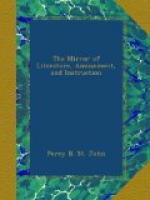The fishmongers consisted of two companies, the salt fishmongers, incorporated in 1433, and the stock fishmongers in 1509. The two companies were united by Henry VIII. in 1536. Before the junction, they are said by Stow, who calls them “jolly citizens,” to have had six halls, two in Thames Street, two in Fish Street, and two in Old Fish Street, and six lord-mayors were elected from their body in twenty-four years. But being charged with forestalling, contrary to the laws and constitutions of the city, they were fined five hundred marks by Edward I. in 1290. In 1384, these, as well as others concerned in furnishing the city with provisions, were put under the immediate direction of the mayor and aldermen, by an act of parliament still in force.[2]
The Hall, on the west side of the ward of Bridge Within, was of brick and stone, and may be said to have had two fronts. The fore entrance was from Thames Street by a handsome passage, leading into a large square court, encompassed by the Great Hall, the Court Room, and other grand apartments, with galleries. The back, or river front, had a double flight of stone steps, by which was an ascent to the first apartments. The door was ornamented with Ionic columns supporting an open pediment, in which was a shield, with the arms of the company. The building was finished with handsomely rusticated stone, and had a noble effect.
The Hall was of capacious proportions, and extended nearly the whole length of the building. The ceiling, as well as that of the adjoining Court Room, exhibited some fine specimens of old plaster-work. We witnessed the dismantling of the premises previous to their being taken down. It was indeed a sorry breaking up. The long tables which had so often, to use a hackneyed phrase, “groaned” beneath the weight of civic fare—the cosy high-backed stuffed chairs which had held many a portly citizen—nay, the very soup-kettles and venison dishes—all were to be submitted to the noisy ordeal of the auction hammer.
We remember in the upper end of the hall, and just behind the chair, there stood in a niche, a full-sized statue, carved in wood by Edward Pierce, statuary, of Sir William Walworth, a member of this company, and lord-mayor during the rebellion of Wat Tyler. The knight grasped a real dagger, said to be the identical weapon with which he stabbed the rebel; though a publican of Islington pretended to be possessed of this dagger, and in 1731, lent it to be publicly exhibited in Smithfield, in a show called “Wat Tyler,” during Bartholomew Fair. Below the niche was this inscription:
“Brave Walworth, knight,
lord-mayor, yt slew
Rebellious Tyler in his alarms;
The king, therefore, did give in lieu
The dagger to the cytye’s
arms.
In the 4th year of Richard II. Anno
Domini 1381.”
A common, but erroneous belief is perpetuated in this inscription, for the dagger was in the city arms long before the time of Sir William Walworth, and was intended to represent the sword of St. Paul, the patron saint of the corporation.




